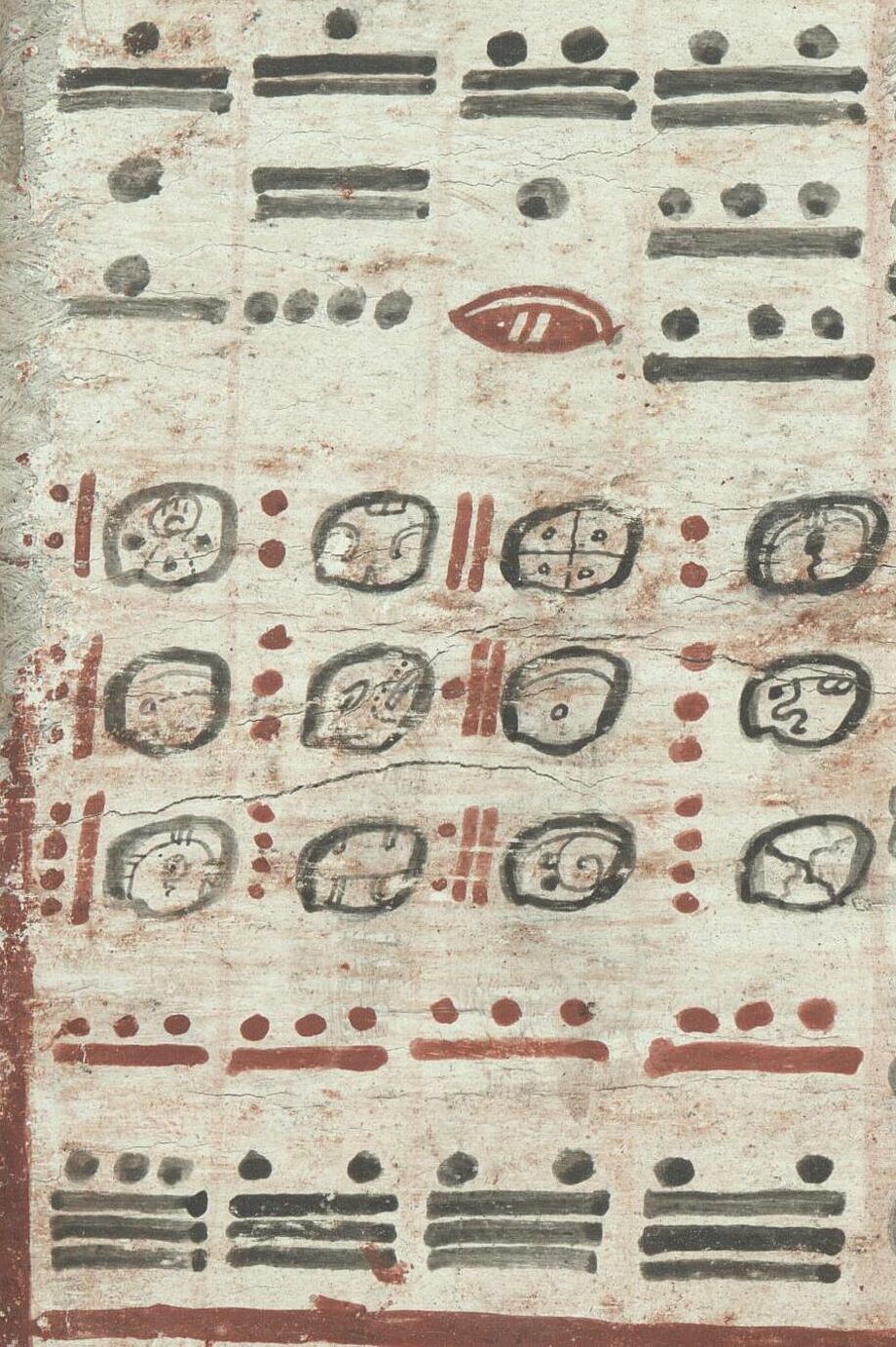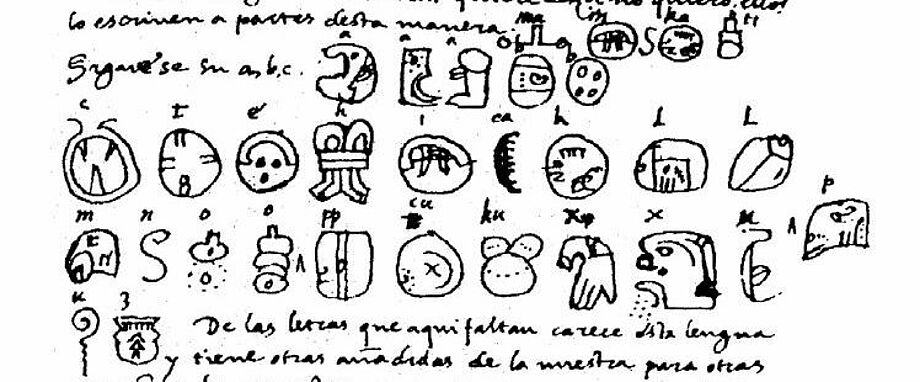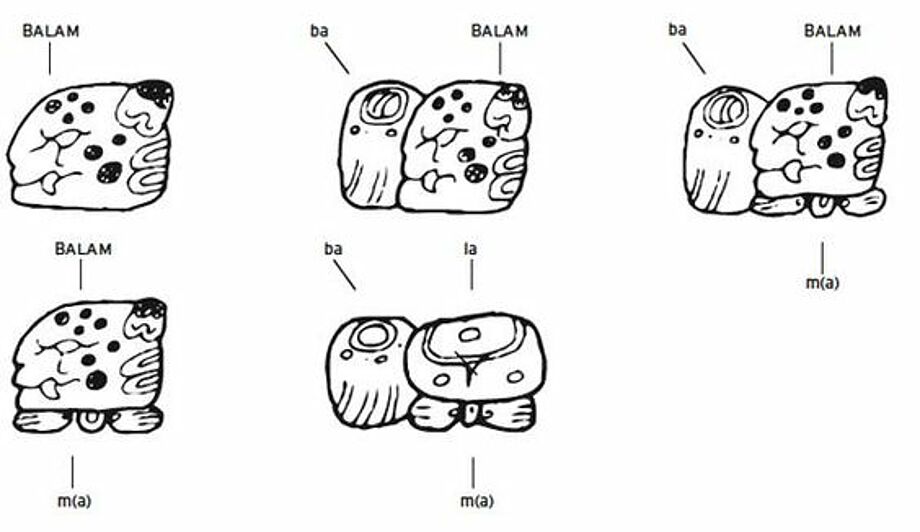Deciphering
Script
The hieroglyphic writing system of the Maya is logosyllabic, i.e. it consists of both logograms (word signs) and syllabograms (syllable signs). Some signs, as ideograms (pictograms), directly represent the designated object. With the help of the syllabic characters the Maya could also write words purely phonetically. The same sound was often reproduced by more than one character. Some of the phonetic characters can also be used as logograms. The round, oval or angular main characters are supplemented by smaller affixes, which are added to the main character as prefixes or suffixes or are integrated into the main character as infixes.
The hieroglyphs are read line by line from left to right in vertical columns of two.
A striking syntactic feature of the Yucatec Mayan language is the sentence order verb - object - subject.
Numerical digits and numeral system
The numbers of the Maya are mostly read column by column from bottom to top, besides characters also horizontally from right to left. The numbers from 1 to 4 were written as dots, the number 5 as bar, the zero mostly as an empty shell. These numerical digits were combined up to the number 19 (3 bars plus 4 dots). Since the Maya calculated in a base-20 numeral system (vigesimal system), with the base number 20 a further position began, which was counted again with dots and lines up to the next value (mathematically 400, with calendar data however 360, the product of 20 days multiplied by 18 months of the solar year Haab). Alternatively, numbers could also be written with 20 different digits in the shape of heads (especially in stone inscriptions; only one time in the Dresden codex in the blue section on page 69).
The highest number found in the Dresden codex is the "snake number" 12,489,781 on page 61.
History of deciphering
In 1566, the Spanish Franciscan Provincial, Inquisitor and later Bishop of Yucatán, Diego de Landa (1524-1579), who had burned numerous Mayan books in front of the Franciscan monastery in Maní in 1562 as evidence of superstition and devilish lies, noted and transcribed them, in his ethnographical justification book "Relación de las cosas de Yucatán", the hieroglyphs for the day and month names of the Maya and tried to establish a relationship between the Maya hieroglyphs and the Spanish alphabet by phonetic means (so-called Landa alphabet) (Relación, chapter XLI [english trans. here])
In 1831 the Leipzig orientalist Heinrich Leberecht Fleischer listed the Codex Dresdensis in his catalogue of oriental manuscripts of the Royal Public Library under the number 451 as a wooden book with pictures, waiting for his Oedipus (who could solve its riddle).
In 1832, the polymath Constantine Samuel Rafinesque-Schmaltz (1783-1840) compared the hieroglyphics of the Dresden Codex with stone inscriptions from Guatemala and Yucatán on the basis of the illustrations in Alexander von Humboldt's "Vues des Cordillères" (1810) and recognised the numerals in the form of dots and bars (Letter to Champollion, February 1832, published in the "Atlantic Journal", Vol. 1, No. 2).
In 1853, the historian and ethnologist Abbé Charles Etienne Brasseur de Bourbourg (1814-1874), in a review of the work "Memoire sur la peinture didactique et écriture figurative des anciens Mexicains" by Joseph Aubin, noted the close relationship between the writing of the Dresden and Paris Codices and inscriptions in Chiapas and Yucatán.
In 1864 Bourbourg edited Diego de Landa's manuscript of the "Relación de las cosas de Yucatán", which he had discovered in 1862 in the library of the Real Academia de la Historia in Madrid, with a French translation, a grammar and a dictionary. On the basis of de Landa's notes, he was able to identify the day and month signs in both the Dresden and the Paris Codex.
In the same year, Theodor Waitz (1821-1864), who studied the original Dresden Codex, considered a phonetic reading of the Mayan hieroglyphics in his "Anthropology of Indigenous Peoples" (vol. 4,2, p. 298).
In 1876, the Orientalist, Old Americanist and ethnologist Léon Louis Lucien Prunol de Rosny concluded in his study "Déchiffrement de l'Écriture Hiératique de l'Amerique Centrale" that the Mayan script consists of both logograms and phonetic signs. He dealt with the images in the Dresden, Madrid and Paris codices, the latter of which he discovered in 1859.
In 1886, Ernst Wilhelm Förstemann (1822-1906), director of the Royal Public Library in Dresden, published his findings on the Maya's numerical and calendar system and their astronomical calculations in his "Erläuterungen" on the Dresden Codex.
In the same year, the lawyer Paul Schellhas (1859-1945), who was in lively exchange with Förstemann, published in a journal article for the first time his observations on the connection between the hieroglyphic texts and the depictions of the gods in the Dresden Maya manuscript.
In 1892/93 the ethnologist Cyrus Thomas (1825-1910) advocated a phonetic reading of Mayan hieroglyphics and compiled syllable tables.
In 1952 the Russian Egyptologist Yuri Valentinovich Knorosov (1922-1999) proved in a short journal article (Sovjetskaja etnografija 3, p. 100-118) that a large part of the Mayan hieroglyphs in the codices is composed of several phonetic units (syllables) and thus found the key to deciphering the Mayan script.
In the 1980s one began to understand the syntax of the classical Yucatec Mayan language. The hieroglyphic texts in the codices mainly have the following structure: verb - object - subject (often a deity). In addition, there are attributes and information about the power of the deity as well as about the offerings.
Of the total of about 650 characters of the Mayan script (including about 200 syllable characters), about 90% could be deciphered more or less reliably. About 85% of the approximately 5,000 surviving text carriers can now be read or at least their content can be interpreted. The Dresden Codex contains 350 different characters, of which 250 have been deciphered so far.
Coe, Michael D.: Das Geheimnis der Maya-Schrift. - Reinbek b. Hamburg: Rowohlt, 1995.
Gronemeyer, Sven; Prager, Christian; Wagner, Elisabeth: Entzifferungsgeschichte, 14./15. Dezember 2014. In: Textdatenbank und Wörterbuch des Klassischen Maya
Harri Kettunen; Christophe Helmke Introduction to Maya hieroglyphs, 16. Aufl., Madrid 2019 (https://www.wayeb.org/wp-content/uploads/2019/04/wh2019english.pdf)



